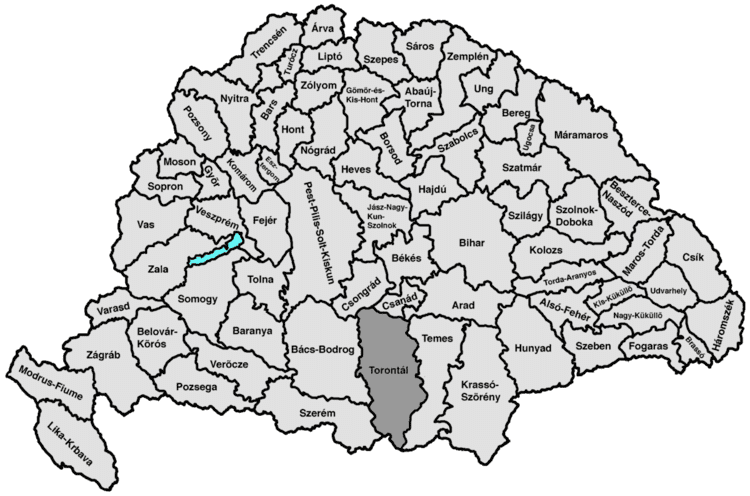Established 14th century | 1910 615,151 | |
 | ||
1910 10,016 km (3,867 sq mi) | ||
Torontál (Hungarian: Torontál, German: Torontal, Serbian: Торонтал, Romanian: Torontal) was an administrative county (comitatus) of the Kingdom of Hungary. Its territory is now in northern Serbia (eastern Vojvodina, except the small part near Belgrade, which is part of Belgrade Region), western Romania and southern Hungary. The capital of the county was Nagybecskerek (Serbian: Велики Бечкерек, German: Großbetschkerek, Romanian: Becicherecu Mare), the current Zrenjanin.
Contents
Geography
Torontál county was located in the Banat region. It shared borders with the Kingdom of Serbia and the Hungarian counties Syrmia, Bács-Bodrog, Csongrád, Csanád, Arad and Temes (the first county was part of Croatia-Slavonia). The river Danube formed its southern border, the river Tisza its western border, and the river Maros (now Mureş) its northern border. Its area was 10,042 km² around 1910.
History
Torontál county was formed before the 15th century. Initial capital was Törökbecse and existed until this area was taken by the Ottoman Empire in the 16th century. During Ottoman administration, this territory was included into the Ottoman Province of Temeşvar. After the Banat was captured by the Habsburg Monarchy in 1718, the area was included into the Banat of Temeswar, a special province, possessed by the Habsburg Emperor. This province was abolished in 1778, and the county of Torontál was restored. It was incorporated into the Habsburg Kingdom of Hungary. Its center was moved temporarily to Nagyszentmiklós (present-day Sânnicolau Mare) between 1807 and 1820 due to a great fire in Nagybecskerek (present-day Zrenjanin).
In 1848/1849 the area of the county was part of Serbian Voivodship, while between 1849 and 1860 it was part of the Voivodeship of Serbia and Banat of Temeschwar, a separate Austrian province (during this time, the county did not existed since new Austrian province was divided into districts). The county was re-established in the 1860s, when the area was again incorporated into the Habsburg Kingdom of Hungary.
In 1918, the county became part of the newly formed Banat Republic, and then part of Banat, Bačka and Baranja region of the Kingdom of Serbia, which subsequently became part of the newly formed Kingdom of Serbs, Croats and Slovenes (later renamed to Yugoslavia). By the Treaty of Trianon of 1920, the area of the county was divided between the Kingdom of Serbs, Croats and Slovenes, Romania, and Hungary. Most of the county was assigned to the Kingdom of Serbs, Croats and Slovenes (which later became Yugoslavia). The north-eastern part of the county was assigned to Romania, and the northernmost part of the county (a small area south of Szeged) was assigned to Hungary and became part of the new county Csanád-Arad-Torontál.
The Yugoslav part of the pre-1918 Torontál county (the western Banat region) is now part of Serbia (mostly in the autonomous region of Vojvodina, except the small part near Belgrade, which is part of Belgrade Region). The Romanian part is now part of Timiş county (called Timiş-Torontal between 1919 and 1950). The Hungarian part is now part of Csongrád county.
1900
In 1900, the county had a population of 609,362 people and was composed of the following linguistic communities:
Total:
According to the census of 1900, the county was composed of the following religious communities:
Total:
1910
In 1910, the county had a population of 615,151 people and was composed of the following linguistic communities:
Total:
According to the census of 1910, the county was composed of the following religious communities:
Total:
Subdivisions
In the early 20th century, the subdivisions of Torontál county were:
